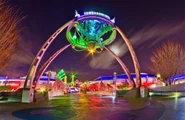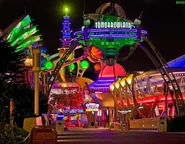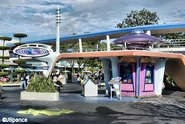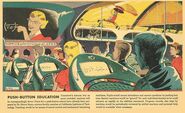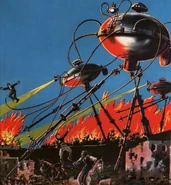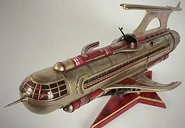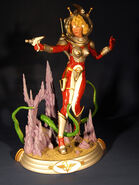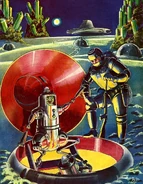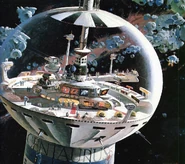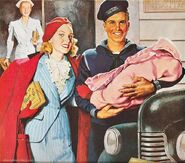| This page needs work. Please help us by expanding it. If you aren't sure how to help, check the article guide Format and Content Reason: Music section needs filling out. |
Raygun Gothic is an aesthetic centered around a view of the future from the perspective of the mid-20th century. It tends to use a distinct, brightly-colored art style similar to comic books and pulp science fiction. Besides fantastic technology, it often depicts imagery associated with "traditionally American" values, particularly a belief in heroism, discovery, the nuclear family and the suburban lifestyle. The aesthetic may vary in intensity from a stylized, slightly sci-fi depiction of Midcentury America to a full-blown Tomorrowland where people live in glowing cities on the moon, spacesuits dictate fashion trends, and intergalactic adventure is common.
Visual[]
Raygun Gothic typically envisions a brightly-coloured space-age utopian society resembling pulp sci-fi comics. It is the light-hearted and optimistic cousin of Atompunk, whereas Atompunk leans on the more dystopian or cynical side of Mid-Century Sci-Fi, often evoking elements of the Cold War, Raygun Gothic emphasizes the potential of technology, especially atomic energy, to improve standards of living. Whether it be seen in theme parks like Tomorrowland, sci-fi adventures like Buzz Lightyear of Star Command, or even the aesthetics of a vintage diner, Raygun Gothic looks to the future with the whimsical hope of the mid-century.
Key features of Raygun Gothic include visual elements borrowed from early to mid-century modern architecture, diners, advertisements, scientific instruments, cars, spacecraft, aircraft, boats, and trains. Shiny or chrome metal is prevalent, as are glowing neon lights, curved or streamlined design, midcentury graphics like starbursts, antennae, fins, radar dishes, stylized metal struts and support beams, grates and grille patterns, laser/energy beams, and vibrant colors featured on vehicles, refrigerators, and other metallic objects of the time.
Another aspect of Raygun Gothic is the fantastic depiction of alien planets and creatures. These also will have vibrant colors and unusual looks. Planets can range from monochrome moonscapes to outrageously imaginative. Aliens will often have brightly colored skin and may resemble a combination of organisms from Earth to give them a more "alien" look. The aliens may vary in personality from mindless monsters to be overcome or friendly altruists willing to help their Earthly neighbors.
Fashion[]
Raygun Gothic fashion tends to draw heavy inspiration from how people in the mid-20th century viewed how the future was going to look. Hence, fashion draws inspiration from existing mid-century fashion and outfits seen in pulp sci-fi of the time. Atompunk fashion such as skirts, boots, and gloves, usually made of a smooth synthetic material such as latex, are typical for women, as are skintight spacesuits invoking the covers of pulp sci-fi comic books (which did tend to be rather sexually suggestive from time to time). More modern iterations of Raygun Gothic tend to emphasize the risqué nature of the fashion. The Raygun Gothic aesthetic also extends to t-shirts, hats, etc. adorned with graphics like starbursts, rockets, atom models, and minimalistic depictions of planets, stars, and galaxies.
Googie[]
The Googie aesthetic, or more accurately known as Googie Architecture, is a subset of Raygun Gothic and Populexe culture and is the chromed geometrical buildings reaching high into the sky that you see in The Jetsons or Tomorrowland. Just as Raygun Gothic did, Googie formed after the collapse of Streamline Moderne at the tail end of the 1930s but, again, like Raygun Gothic, only became a proper style around 1945; unlike Raygun Gothic however, it only became truly popular at the tail end of the 1940s in 1949 with the construction of Googie's Coffee Shop.
Cultural Context[]
The Raygun Gothic aesthetic took place in the late 1940s after the collapse of Dieselpunk, and is a reflection of the generally optimistic outlook people at the time had of the future. It functions as an escape from the hardships and cultural cynicism people would experience in the second half of the 20th century, showcasing a beautiful space age wonderland where all of humanity's problems were resolved (or at least improved) by advanced technology and the promise of a brighter tomorrow. Visually, it took influence from science fiction of the 1930s and 1940s, especially pulp magazine covers and comics such as Flash Gordon and Buck Rodgers. It also takes influence from The Space Age, starting with the V-2 rocket launch in 1946 and ending with the moon landing in 1972. It would be succeeded by the more minimalistic Cassette Futurism.
The term Raygun Gothic was actually coined in 1981 by William Gibson in his short story The Gernsback Continuum, close to two decades after it fell out of popularity, though the story itself falls more under Atompunk instead, also known in context as 'The Tomorrow that Never Was'. Despite this, there have been false attributions of Raygun Gothic being a darker future of the 1960s. Despite it originally being used to describe Streamline Moderne, it is now a term linked to The Googie aesthetic.
Media[]
Literature[]
- Buck Rogers (1929)
- Flash Gordon (1934)
- The Martian Chronicles (1950)
- I, Robot (1950)
- Starship Troopers (1959)
Television[]
- Man in Space (1955)
- Man and the Moon (1955)
- Mars and Beyond (1957)
- Our Friend the Atom (1957)
- Colonel Bleep (1957)
- The Jetsons (1962)
- Lost in Space (1965)
- Star Trek (1966)
- Speed Racer (1966)
- Buzz Lightyear of Star Command (2000-2001)
- My Life as a Teenage Robot (2002-2006)
- Duck Dodgers (2003-2005)
- Atomic Betty (2004)
Film[]
- Flash Gordon (1936)
- Buck Rogers (1939)
- The Day the Earth Stood Still (1951)
- Forbidden Planet (1956)
- Plan 9 from Outer Space (1959)
- Meet the Robinsons (2007)
- Tomorrowland (2015)
Video Games[]
- Outer Wilds (2019)
- No Man’s Sky (2016)
Music[]
Songs[]
- Space Age Pop
- Intergalactic by Beastie Boys
- Rocket by Goldfrapp
- Come Alive by Chromeo
- Space Junk by Wang Chung
- Sci-Fi Wasabi by Cibo Matto


